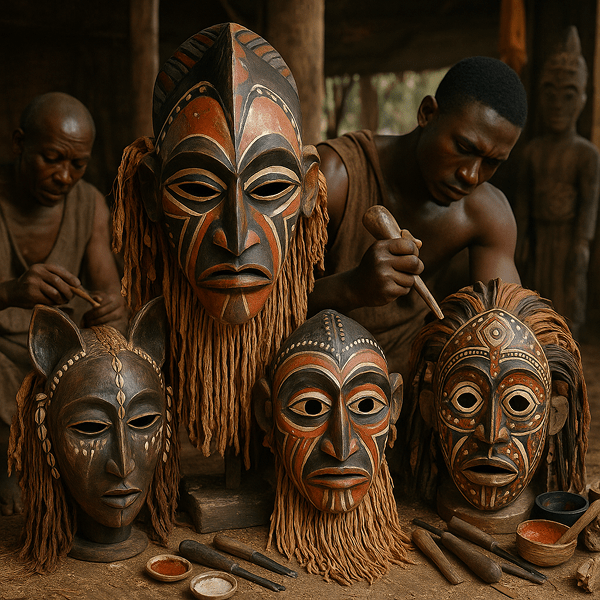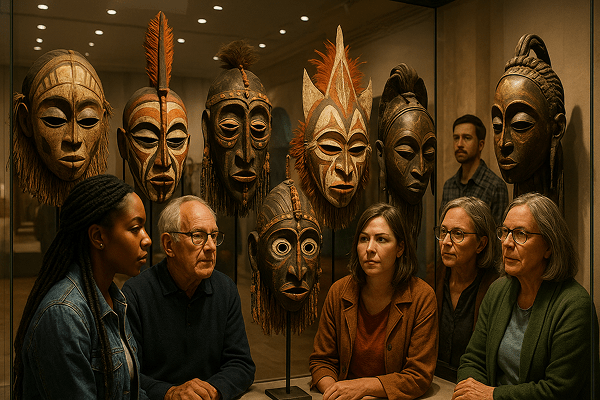Ritual Initiation Masks are some of the most profound and visually striking artifacts in the world’s cultural heritage, essential to rites of passage and transformation across continents. These masks are distinguished by their dramatic, symbolic features — elongated faces, striking eyes, bold geometric patterns, and intricate adornments made of beads, shells, feathers, raffia, or animal hair. Often masking the wearer’s entire head or face, they create an aura of awe and mystery, signaling a journey from childhood to adulthood, or from one social status to another. Ritual Initiation Masks are especially prominent in sub-Saharan Africa, Melanesia, Papua New Guinea, and among some Indigenous peoples of the Americas and Oceania. Their origins stretch back centuries, and their use persists in many traditional societies today.
Historical Origins of Ritual Initiation Masks
The history of Ritual Initiation Masks is deeply connected to the development of initiation rites — ceremonies that mark critical life transitions. The word “initiation” comes from the Latin “initiare,” meaning “to begin” or “to enter upon.” Masked initiation rituals likely emerged in prehistoric times as a way to symbolize the death of the old self and rebirth into a new social or spiritual role. Over millennia, initiation masks have evolved in design and function, shaped by local beliefs, climate, and contact with neighboring cultures. In many African societies, masks are integral to secret societies such as the Poro (West Africa) or Sande (Sierra Leone and Liberia), which guide boys and girls through elaborate training and symbolic death-and-rebirth experiences. Archaeological finds, oral histories, and early ethnographic accounts all attest to the central place of masks in initiation. As these traditions spread and diversified, masks became highly specialized, with each region developing unique forms, motifs, and ceremonies. The close relationship between Initiation Masks and other ritual objects, such as Fertility Masks, reflects the interconnectedness of life-cycle rituals.
Cultural Significance and Symbolism of Initiation Masks
Initiation Masks embody deep cultural meaning and spiritual power. In their native context, they serve as both a physical disguise and a vessel for ancestral or supernatural forces. The mask wearer becomes a living symbol of the community’s values, myths, and cosmology. In many African cultures, for example, the mask represents an ancestor or spirit who instructs initiates in the secrets of adulthood, morality, and social responsibility. The dramatic features of the mask — oversized eyes, fierce expressions, animal motifs — are designed to inspire awe, fear, or respect, reinforcing the seriousness of the rite. Myths and legends often recount the origins of particular masks and their protective or transformative powers. Socially, initiation masks provide a framework for communal teaching, reinforcing gender roles, kinship ties, and the continuity of tradition. Religious aspects are vital: the mask mediates between the visible and invisible worlds, ensuring the successful passage of the initiate and the well-being of the community.
Materials and Craft Techniques of Initiation Masks
The making of Ritual Initiation Masks is a highly skilled and often sacred craft. Traditional masks are usually carved from local hardwoods, but may also incorporate bark, woven fiber, clay, leather, or bone. Artisans use knives, chisels, adzes, and sometimes fire to shape and hollow the mask. Decoration is elaborate: natural pigments (ochre, charcoal, kaolin), beads, shells, cowries (symbols of fertility and wealth), feathers, raffia, and animal hair are applied using time-honored techniques. Each region has its own stylistic canons — for example, the elongated, highly stylized masks of the Fang in Gabon, or the rounded, helmet-like masks of the Bwa in Burkina Faso. Color symbolism is paramount: red for power or transformation, white for purity and ancestral spirits, black for the unknown or the supernatural. Special rituals often accompany the mask’s creation, imbuing it with spiritual force before it is used in ceremony.

Functions and Uses of Initiation Masks
The primary function of Ritual Initiation Masks is ceremonial, used in rites of passage that mark the transition from childhood to adulthood, or from one social role to another. During initiation, masked elders or society members perform dances, songs, and teachings that impart moral values, cultural knowledge, and practical skills. The mask’s dramatic appearance serves to awe initiates, enforce secrecy, and symbolize the liminal, in-between state of the ritual. In some regions, masks are also used in public festivals, harvest celebrations, or healing ceremonies, reflecting the fluidity of ritual roles. Theatrical elements — storytelling, music, and dance — are integral, transforming the rite into a powerful communal drama. Over time, the use of initiation masks has adapted to changing social realities; today, they may appear in cultural exhibitions, contemporary performances, or serve as symbols of identity and resilience.
Regional Variations of Initiation Masks
Initiation Masks display remarkable regional diversity, shaped by local beliefs, materials, and histories. In West Africa, the Sande society’s helmet masks represent female beauty and wisdom, while the Poro society’s masks embody male ancestral power. The Yoruba Egungun masks are towering, multi-layered costumes that represent returning ancestors. In Central Africa, the Mukanda masks of the Chokwe and neighboring peoples are carved with intricate geometric patterns and worn during boys’ bush camps. In Melanesia and Papua New Guinea, initiation masks may be made from woven fiber, bark, or clay, featuring animal or ancestral motifs. Indigenous American societies have their own initiation mask traditions, often linked to coming-of-age ceremonies. Each mask’s design, use, and meaning are unique, yet all underscore the universal importance of transition and transformation in human societies.
Famous Examples and Collections of Initiation Masks
Some of the world’s most significant Initiation Masks are preserved in museum and private collections. The Musée du Quai Branly (Paris), the British Museum (London), and the Smithsonian National Museum of African Art (Washington, D.C.) house renowned examples from Africa, Oceania, and the Americas. Notable pieces include the Sande society’s helmet masks, the Bwa plank masks of Burkina Faso, and the Chokwe mukanda masks of Angola. Important archaeological finds and early ethnographic collections provide insight into the history and evolution of these masks. Online resources and virtual galleries, such as toddmasks.com, offer expert analysis, high-resolution images, and access to rare examples for scholars and the public alike.

Influence of Initiation Masks on Art and Culture
Initiation Masks have had a lasting impact on global art, literature, and visual culture. Their bold forms and symbolic power influenced early modernist artists such as Pablo Picasso and André Derain, who saw in African masks a new way to express emotion and abstraction. In literature and film, initiation masks often symbolize transformation, secrecy, or the journey to maturity. Contemporary designers draw on mask motifs for fashion, jewelry, and stage design, blending tradition with innovation. The preservation and reinterpretation of initiation mask traditions play a vital role in cultural education, heritage conservation, and creative expression, both within source communities and worldwide.
Contemporary Status and Preservation of Initiation Mask Traditions
Today, the tradition of Ritual Initiation Masks is both challenged and revitalized by social change, migration, and globalization. While some initiation ceremonies have declined due to urbanization or religious shifts, many communities and master artisans continue to sustain and adapt their practices. Cultural organizations, museums, and festivals support mask-making through apprenticeships, exhibitions, and performances. Educational programs and masterclasses — often highlighted on toddmasks.com — ensure the transmission of knowledge to younger generations and international audiences. Modern artists experiment with new materials and forms, keeping the tradition relevant in contemporary culture. Preservation efforts emphasize ethical collecting, documentation, and respect for the spiritual origins of initiation masks.
Collecting and Acquiring Initiation Masks
The market for Initiation Masks is diverse, with authentic ceremonial pieces, high-quality replicas, and modern interpretations available from artisan workshops, galleries, museums, and online platforms. Prices vary according to age, craftsmanship, provenance, and artistic value. Collectors should seek expert advice, verify authenticity, and prioritize ethical sources that support local artists and communities. Toddmasks.com offers expert guidance on collecting, authentication, and ethical considerations. Responsible collecting helps ensure that masks are respected as cultural treasures rather than commodities, supporting heritage preservation and community well-being.
